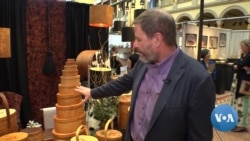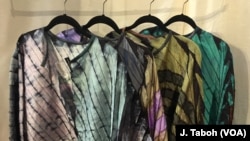The United Nations says more than one million plant and animal species are likely to die out because of human activity. That threat to the environment and concerns about climate change influenced people attending the Smithsonian Craft Show last month.
The show recognized artists who are creating environmentally sustainable work.
The Smithsonian Women’s Committee is made up of volunteers from the Washington, D.C. area. JoAnn Symons is the group’s president.
“In recent years, we've noticed that the artists in our shows have been working with more renewable materials and methods that are environmentally safe. So we’ve decided that we would reward those efforts by offering a Sustainability Award every year at our show.”
At the show last month, 120 artists from across the United States presented works of art in 12 different media or materials. They included glass, wood and objects made from animal skin.
Twenty-one artists met the requirements for sustainability. By doing so, they won the right to compete for the Honoring the Future® Sustainability Award. The winner received a prize of $1,000.
Michigan woodworker John Guertin is one of the 21 artists. He makes birdhouses with wood he recovers from old barns, after the buildings have fallen into disrepair.
“If you can use recycled material from old sources to bring new generations of birds into the world -- and other creatures -- it makes a wonderful statement about our purpose in the world, that we don’t just exploit it, but rather we give something back.”
Guertin’s creations include birdhouses for owls and even bats. Some look like real buildings, including one created for the Mission San Luis Rey Museum in Oceanside, California. Guertin said he once made a birdhouse for the daughter of former United States president Gerald Ford.
Nashville, Tennessee artist Tim Arnold creates wooden boxes similar to those made by a religious group: the Shakers. The group’s members were known for making simple, well-built chairs and other furniture.
Arnold says he tries to honor that centuries old tradition, but at the same time give his artwork a personal touch. He often adds interesting, often unusual objects to the tops of his boxes. For example, one box for needlework has a pair of magnetized scissors on top of it. He also uses unusual materials, such as copper and animal skins.
Mary Jaeger creates her works of art in a nearly 100-year-old factory building in Brooklyn, New York. She makes artwork that can be worn as clothing. It combines the time-honored qualities of Japanese textiles with modern Western designs.
Jaeger won the “Honoring the Future® Sustainability Award” for her silk creations. She makes them by hand, combining earlier projects with leftover, repurposed materials.
The artist said, “When I look at these beautiful silks that I've acquired over the years of designing, I wanted to repurpose them into something that was truly beautiful, but completely different than the original product...”
Fran Dubrowski heads Honoring the Future, the nonprofit organization that provided the sustainability award. She said the group was set up “to harness the power of art to educate and engage the public on climate change.”
She added, “We’re trying to encourage the craft artist to really discuss sustainability with the visitors to their show, not just practice it at home.”
I’m Jonathan Evans.
Julie Taboh wrote this story for VOANews.com. Jonathan Evans adapted it for Learning English. George Grow was the editor.
______________________________________________________________
Words in This Story
bat – n. an animal that has wings and a furry body like a mouse
exploit – v. to get value or use from something; to use someone or something in a way that helps you unfairly
harness – v. to use something for a particular purpose
practice – v. to do something again and again in order to become better at it
recycled – n. something that has been used before
silk – n. a smooth, soft, and shiny cloth that is made from thread produced by silkworms
sustainable – adj. able to be used without being completely used up or destroyed
textiles – n. fabric; cloth












